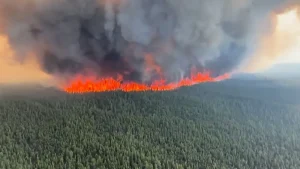
Glyphosate is the main pesticide being sprayed on Canadian forests, and it increases the risk of forest fires.
2023 Forest Fires
The 2023 forest fires in Canada were devastating and destructive. Almost 19 million hectares of forest were burned – markedly more than the previous average of 2.5 million hectares. Hundreds of fires exceeded 10,000 hectares and were considered ““megafires”. (NASA Earth Observatory) Some fires smoldered underground and are emerging as “zombies” fires.
Smoke emitted from the wildfires caused air quality alerts and evacuations in Canada and the United States. In late June, 2023, the smoke crossed the Atlantic, reaching Europe.
Contributing Factors
Climate change is considered a contributing factor. Warmer and drier weather makes vegetation more flammable, increasing the risk of fire.
The forest management practise of spraying with glyphosate is also a contributing factor, in at least two respects. First, spraying the forest with glyphosate- based herbicides dries down the forest even more. Second, spraying and killing deciduous (leafy) trees in order to plant evergreens (conifers) removes a fire barrier.
- Glyphosate Spraying Dries Down Forests
Glyphosate is used in agriculture as a desiccant, to “dry-down” weeds and crops. It kills or severely weakens all vegetation, except plants that either are genetically modified to withstand it, that don’t easily absorb it, or that have become resistant to it. Safe Food Matters Inc. is in court with Health Canada concerning the harms arising from the practise in agriculture.
Glyphosate is also sprayed on forest vegetation for “dry-down” purposes. The targeted trees for killing are broadleaf, leafy deciduous trees.
The focus of forest management is production of conifer (evergreen) trees in conifer plantations. Glyphosate products are sprayed on forest parcels to clear them of vegetation prior to transplanting conifer seedlings, and glyphosate is also sprayed once transplanting has occurred to kill leafy vegetation and trees that compete with and outgrow the seedlings.
The vegetation dies and/or dries, contributing flammable material to the forest floor.
- Leafy/Deciduous Trees More Fire Resistant that Conifers
Evergreen/conifer varieties “burn anywhere from 5 to ten times faster than other species of leafy trees” according to the Alberta Government publication “How different tree species impact the spread of wildfire”. The reasons include evergreens/conifers have sap which burns easily, they grow closer together which allows fire to spread from tree top to tree top, they have low lying branches which catch easily from the forest floor, and their rough, loose bark produces embers and can also act as a ladder allowing fire to climb up to the canopy.
In contrast, deciduous stands act as a natural fire break. There is usually a lack of ladder fuels in deciduous stands, so fire does not get carried to the high crowns of the trees. The properties of the trees themselves also mitigate against the spread of fire: high crown height; higher moisture content of leaves and stems; and tight smooth bark which does not act as a ladder.
- Deciduous Trees Declining/ Conversion to Conifer Plantations
Forest companies plant conifer trees because they grow quickly, and the companies are obligated to replant and ensure the trees are “free to grow” or “established” within a certain time frame. This is embedded into the law and/or licenses granted to the companies, and is considered part of “sustainable forest management”.
The State of Canada’s Forests Annual Report for 2023 states that “around 85% of the total area harvested in Canada is through clearcutting” (p.34). Because of the preference for planting conifers, the practice of spraying with glyphosate has become an integral part of establishing forest plantations on clearcut sites. When a site is clearcut, deciduous trees spring up quickly making it difficult for conifers to get established naturally and for tree planters to plant the site with conifers. So the sites is sprayed, in a practice called “site preparation”. It may be sprayed again for “conifer release”, meaning releasing the conifer from deciduous competition by killing the vegetation around the conifer.
Conifers are the predominant type of tree being planted in our forests. Few deciduous trees are planted on clearcut sites, even though clearcutting removes all species of trees. This, in effect, converts forests into conifer plantations.
By way of example, Ontario reports in Ontario’s report State of Ontario’s Natural Resources – Forest 2021 that 41% of the harvested wood was spruce, 27% of the harvested wood was jack pine and 16% of the harvested wood was poplar. But when it comes to planting, there is no mention of replanting the deciduous poplar:
“Tree planting was the main method of assisted regeneration. On average we planted 53% spruce and 38% jack pine.”
Significantly, data on replanting from 1990 to 2020 in the National Forest Database shows that large amounts of pine and spruce have been and continue to be planted on provincial Crown land, in contrast to few hardwood (deciduous) trees. Almost 12 million hectares of conifers have been planted, compared to only 61,000 hectares of deciduous trees. In other words, the area being replanted by conifers exceeds that of deciduous by a factor of 193. This means almost 200 times as many conifers as deciduous are being replanted in Canadian forests.
6.5 Area (hectares) planted by ownership and species group from 1990 to 2020:
| Province | Spruce | Pine | Douglas Fir | Combined conifer planted | Miscellaneous hardwood planted |
| British Columbia | 1744180 | 2774361 | 476048 | 4994589 | 7173 |
| Alberta | 1041510 | 773906 | 264 | 1815680 | 2665 |
| Saskatchewan | 231198 | 43753 | 274951 | ||
| Manitoba | 159497 | 31529 | 191026 | ||
| Ontario | 1170594 | 808532 | 1979126 | 33673 | |
| Quebec | 1598366 | 460429 | 2058795 | 17553 | |
| New Brunswick | 282876 | 44124 | 327000 | ||
| Nova Scotia | 60176 | 631 | 60807 | ||
| Prince Edward Island | 1399 | 503 | 1902 | 176 | |
| Newfoundland | 118118 | 4543 | 122661 | ||
| Northwest Territories | 1845 | 22 | 1867 | ||
| Yukon | 4444 | 719 | 5163 | 13 | |
| TOTAL: | 11833567 | 61253 |
Stop the Spray
Spraying with glyphosate increases forest fire risk because it dries down forest growth – thereby creating forest fuel. It also facilitates the conversion of forests into conifer plantations, which are tinderboxes in effect.
The risk of harm from spraying forests with glyphosate herbicides clearly outweighs the benefits. Reason and common sense dictate the practise must stop.
This post is part of a series on Forest Spraying being published, including posts on faulty approval, unsafe food and increased risk of forest fires. Please consider supporting our work and lawsuits against glyphosate by contributing here.

